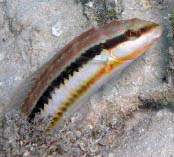|
| Links |
We parsed the following live from the Web into this page. Such content is managed by its original site and not cached on Discover Life. Please send feedback and corrections directly to the source. See original regarding copyrights and terms of use.
- FishBase
|
|
Following modified from FishBase
|
Top | See original
http://www.fishbase.org/Summary/speciesSummary.php?genusname=Halichoeres&speciesname=bivittatus ---> http://192.134.151.83/Summary/speciesSummary.php?genusname=Halichoeres&speciesname=bivittatus
http://192.134.151.83/Summary/speciesSummary.php?genusname=Halichoeres&speciesname=bivittatus ---> https://fishbase.mnhn.fr/Summary/speciesSummary.php?genusname=Halichoeres&speciesname=bivittatus
https://fishbase.mnhn.fr/Summary/speciesSummary.php?genusname=Halichoeres&speciesname=bivittatus ---> https://fishbase.mnhn.fr/summary/Halichoeres-bivittatus.html
Halichoeres bivittatus, Slippery dick : aquarium

You can
sponsor
this page
Common name (e.g. trout)
Genus + Species (e.g. Gadus morhua)
-

-
About this page
-
Languages
-
User feedbacks
-
Citation
-
Uploads
-
Related species
-


 Slippery dick
Add your observation in
Fish Watcher
Upload your
photos
and
videos
Slippery dick
Add your observation in
Fish Watcher
Upload your
photos
and
videos
Pictures
|
Videos |
Google image
 Halichoeres bivittatus
Halichoeres bivittatus
Picture by
Steele, M.A.
Teleostei (teleosts) >
Eupercaria/misc
(Various families in series Eupercaria) >
Labridae
(Wrasses) > Corinae
Etymology:
Halichoeres:
Greek, als, alis = salt + Greek, choiros = pig (Ref.
45335
)
.
More on author:
Bloch
.
Environment: milieu / climate zone / depth range / distribution range
Ecology
Marine; reef-associated; depth range 1 - 15 m (Ref.
9710
). Tropical; 37°N - 26°S, 100°W - 28°W
Western Atlantic: North Carolina, USA and Bermuda to Brazil (Ref.
7251
).
Size / Weight / Age
Maturity: L
m
?
range ? - ? cm
Max length : 35.0 cm TL male/unsexed; (Ref.
55367
); max. published weight: 146.00 g (Ref.
9626
)
Dorsal
spines
(total): 9;
Anal
spines
: 3;
Anal
soft rays
: 12. The dominant color markings are two dark stripes, one running from snout through eye to caudal base and the other, less pronounced, on lower side of body; a bicolored spot at edge of gill cover within upper dark stripe; large adult males green on back, shading to light greenish yellow on sides, the two stripes usually purplish; irregular light red bands on head and on caudal fin (Ref.
13442
).
Commonly found in rocky and reef areas in shallow waters. Less common in seagrass beds. Feeds on other fishes (Ref.
5521
) and gastropods (Ref.
9626
). Forms leks during breeding (Ref.
55367
). A protogynous hermaphrodite (Ref.
55367
).
Life cycle and mating behavior
Maturity
|
Reproduction
|
Spawning
|
Eggs
|
Fecundity
|
Larvae
Diandric. Pelagic spawner (Ref.
32222
). Sex reversal is completed in more than 3-4 weeks (Ref.
34185
,
34257
). Length at sex change = 30.2 cm TL (Ref.
55367
).
Robins, C.R. and G.C. Ray
, 1986. A field guide to Atlantic coast fishes of North America. Houghton Mifflin Company, Boston, U.S.A. 354 p. (Ref.
7251
)
IUCN Red List Status (Ref.
130435
)
Least Concern (LC)
; Date assessed:
12 March 2008
CITES
Not Evaluated
Not Evaluated
Threat to humans
Harmless
Human uses
Aquarium: commercial
FAO - Publication:
search
|
FishSource
|
More information
Countries
FAO areas
Ecosystems
Occurrences
Introductions
Stocks
Ecology
Diet
Food items
Food consumption
Ration
Common names
Synonyms
Metabolism
Predators
Ecotoxicology
Reproduction
Maturity
Spawning
Spawning aggregation
Fecundity
Eggs
Egg development
Age/Size
Growth
Length-weight
Length-length
Length-frequencies
Morphometrics
Morphology
Larvae
Larval dynamics
Recruitment
Abundance
BRUVS
References
Aquaculture
Aquaculture profile
Strains
Genetics
Electrophoreses
Heritability
Diseases
Processing
Nutrients
Mass conversion
Collaborators
Pictures
Stamps, Coins Misc.
Sounds
Ciguatera
Speed
Swim. type
Gill area
Otoliths
Brains
Vision
Tools
Bio-Quiz
|
E-book
|
Field guide
|
Identification keys
|
Length-frequency wizard
|
Life-history tool
|
Point map
|
Classification Tree
|
Catch-MSY
|
Special reports
Check for Aquarium maintenance
|
Check for Species Fact Sheets
|
Check for Aquaculture Fact Sheets
Download XML
Summary page
|
Point data
|
Common names
|
Photos
Internet sources
AFORO (otoliths) |
Aquatic Commons
|
BHL
|
Cloffa
|
BOLDSystems
|
Websites from users
|
Check FishWatcher
|
CISTI
|
Catalog of Fishes
:
genus
,
species
|
DiscoverLife
|
ECOTOX
| FAO - Publication:
search
|
Faunafri
| Fishipedia |
Fishtrace
| GenBank:
genome
,
nucleotide
|
GloBI
|
GoMexSI
(interaction data)
|
Google Books
|
Google Scholar
|
Google
| IGFA World Record |
MitoFish
|
National databases
|
Otolith Atlas of Taiwan Fishes
|
Public aquariums
|
PubMed
|
Reef Life Survey
| Socotra Atlas |
Tree of Life
| Wikipedia:
Go
,
Search
| World Records Freshwater Fishing |
Zoological Record
Estimates based on models
Preferred temperature (Ref.
123201
): 24.4 - 28.2, mean 27.3 °C (based on 713 cells).
Phylogenetic diversity index (Ref.
82804
): PD
50
= 0.5000 [Uniqueness, from 0.5 = low to 2.0 = high].
Bayesian length-weight: a=0.00912 (0.00581 - 0.01432), b=3.07 (2.94 - 3.20), in cm total length, based on LWR estimates for this species & Genus-body shape (Ref.
93245
).
Trophic level (Ref.
69278
): 3.8 ±0.1 se; based on diet studies.
Resilience (Ref.
120179
): Medium, minimum population doubling time 1.4 - 4.4 years (Preliminary K or Fecundity.).
Fishing Vulnerability (Ref.
59153
): Low vulnerability (25 of 100).
Nutrients (Ref.
124155
): Calcium = 49.8 [30.1, 82.1] mg/100g; Iron = 0.566 [0.328, 1.026] mg/100g; Protein = 18.8 [15.9, 21.0] %; Omega3 = 0.13 [0.09, 0.20] g/100g; Selenium = 23.2 [14.0, 42.4] μg/100g; VitaminA = 115 [35, 409] μg/100g; Zinc = 1.3 [0.9, 2.0] mg/100g (wet weight);
Back to Search
Random Species
Back to Top
Accessed through:
Not available
FishBase mirror site :
localhost
Page last modified by :
mrius-barile
- 20 July 2016
Fatal error
: Uncaught ArgumentCountError: Too few arguments to function checkEcotox(), 1 passed in /var/www/html/summary/speciessummary.php on line 2304 and exactly 3 expected in /var/www/html/includes/speciessummary.lib.php:2579 Stack trace: #0 /var/www/html/summary/speciessummary.php(2304): checkEcotox() #1 {main} thrown in
/var/www/html/includes/speciessummary.lib.php
on line
2579
|
Updated: 2024-05-24 16:10:03 gmt
|